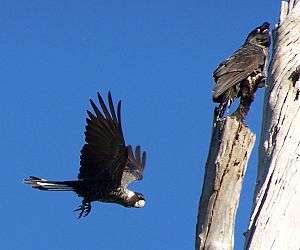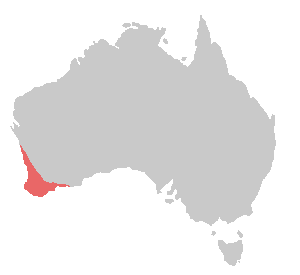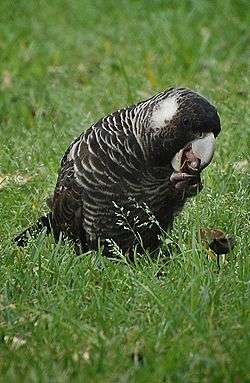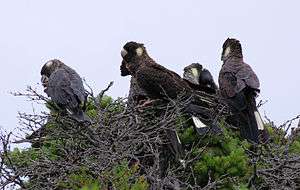Carnaby's black cockatoo
| Carnaby's black cockatoo | |
|---|---|
 | |
| Female flying and male perching on tree | |
| Scientific classification | |
| Kingdom: | Animalia |
| Phylum: | Chordata |
| Class: | Aves |
| Order: | Psittaciformes |
| Superfamily: | Cacatuoidea |
| Family: | Cacatuidae |
| Subfamily: | Calyptorhynchinae |
| Genus: | Calyptorhynchus |
| Subgenus: | Zanda |
| Species: | C. latirostris |
| Binomial name | |
| Calyptorhynchus latirostris Carnaby, 1948 | |
 | |
| Range in red | |
| Synonyms | |
|
Calyptorhynchus funereus latirostris | |
Carnaby's black cockatoo (Calyptorhynchus latirostris), also known as the short-billed black cockatoo, is a large black cockatoo endemic to south-western Australia. It was described in 1948 by naturalist Ivan Carnaby. Measuring 53–58 cm (21–23 in) in length, it has a short crest on the top of its head. Its plumage is mostly greyish black and it has prominent white cheek patches and a white tail band. The body feathers are edged with white giving a scalloped appearance. Adult males have a dark grey beak and pink eye-rings. Adult females have a bone coloured beak, grey eye-rings and ear patches that are paler than those of the males.
Threatened by habitat destruction, Carnaby's black cockatoo is listed as endangered by the Federal and Western Australian governments.
Taxonomy and naming
This and Baudin's (or long-billed) black cockatoo were known collectively as the white-tailed black cockatoo until formally classified as separate species. In a 1933 report on the birds of Lake Grace, Western Australian naturalist Ivan Carnaby wrote of a distinctive population of white-tailed black cockatoos that he named mallee black cockatoos. These birds lived in mallee and sandplains, using their large bills to crack open woody seed pods, while the typical form had a long narrow bill it used to extract eucalyptus seeds from red gum seed pods.[2] He classified it as a subspecies of the white-tailed black cockatoo in 1948, giving it the name Calyptorhynchus baudinii latirostris.[3] The epithet latirostris is from the Latin latus "wide" and rostrum "bill.[4] The holotype specimen is from Hopetoun, Western Australia.[5] The two taxa were called short-billed and long-billed black cockatoos in scientific works, yet they were called Carnaby's and Baudin's black cockatoo in Western Australia. Hence ornithologists Les Christidis and Walter Boles pushed for the latter two names to be used.[6] The International Ornithologists' Union has taken up this suggestion and uses these names as their official common names.[7] The local indigenous people did not distinguish between Carnaby's and Baudin's black cockatoos. Names recorded include ngolyenok, ngoolyoo (from Northampton), G’noo-le-a (from Geraldton) and Gnowl-ya (from the eastern part of Shark Bay).[8]
Within the genus, the two Western Australian white-tailed species, Carnaby's and the Baudin's black cockatoo, together with the yellow-tailed black cockatoo of eastern Australia form the subgenus Zanda. The red-tailed and glossy black cockatoos form the other subgenus, Calyptorhynchus. The two groups are distinguished by differing juvenile food begging calls and the degree of sexual dimorphism. Males and females of the latter group have markedly different plumage, whereas those of the former have similar plumage.[6]
The three species of the subgenus Zanda have been variously considered as two, then as a single species for many years. In a 1979 paper, Australian ornithologist Denis Saunders highlighted the similarity between the short-billed and the southern race xanthanotus of the yellow-tailed and treated them as a single species with the long-billed as a distinct species. He proposed that Western Australia had been colonised on two separate occasions, once by a common ancestor of all three forms (which became the long-billed black cockatoo), and later by what has become the short-billed black cockatoo.[9] However, an analysis of protein allozymes published in 1984 revealed the two Western Australian forms to be more closely related to each other than to the yellow-tailed,[10] and the consensus since then has been to treat them as three separate species.[6]
Description

Carnaby's black cockatoo is 53–58 cm (21–23 in) in length with a 110 cm (43 in) wingspan, and weighs 520–790 grams. It is mostly dark grey, with narrow light grey scalloping produced by narrow pale grey margins at the tips of dark feathers. It has a crest of short feathers on its head, with whitish patches of feathers that cover the ears. Its lateral tail feathers are white with black tips, and the central tail feathers all black. The irises are dark brown and the legs brown-grey. Its beak is shorter and broader than that of the closely related and similar long-billed black cockatoo; the two are often difficult to distinguish in the field.[11]
Adult males have a dark grey beak and pink eye-rings. Adult females have a bone coloured beak, grey eye-rings and ear patches that are whiter and more distinctive than those of the males. Juveniles have a bone coloured beak, grey eye-rings, and less white in the tail feathers.[11]
Distribution and habitat

Carnaby's black cockatoo is found across a broad swathe of southwestern Australia in places that get over 300 mm (12 in) of rainfall yearly. Breeding takes place in areas receiving 350–700 mm (14–28 in) rainfall a year, generally in the wheatbelt. Outside the breeding season, the cockatoo pairs form flocks and move south and west towards the coast.
Status and conservation
The cockatoo is recognised as Endangered under the federal Environment Protection and Biodiversity Conservation Act 1999,[12] and as Schedule 1 "fauna that is rare or is likely to become extinct" by Western Australia's Wildlife Conservation (Specially Protected Fauna) Notice 2008(2) under the Wildlife Conservation Act 1950. The population size of Carnaby's cockatoo fell by over 50% over 45 years, and up to a third of their traditional breeding grounds in the Wheatbelt region have been abandoned.[13]
Major threats to the cockatoo include clearance of their feeding and nesting habitat, destruction of nesting hollows (e.g. during firewood collection), competition with other species for nest sites, and poaching.[14]
Their habit of forming flocks predisposes them to outbreaks of disease and localized adverse weather events. A probable outbreak of a disease led to the deaths of up to 23 breeding female cockatoos at Koobabbie in September–October 2009, a hailstorm killed 68 individuals around Perth on 22 March 2010, and 145 perished in a heatwave around Hopetoun when temperatures reached 48 C on 6 January 2010. Temperature and weather extremes in southwestern Australia are predicted to worsen with climate change.[15]
Carnaby's black cockatoos brought to veterinary hospitals with traumatic injuries.[16] Motor vehicles are a hazard, as much vegetation useful to Carnaby's black cockatoos lies on road verges.[15] The cockatoos fly into open space when leaving the vegetation, which is often over a road and in the path of oncoming traffic.[16]
The bird is part of an annual census, the Great Cocky count, that has been held every year since 2009 to track the population change of Carnaby's and other black cockatoos.[17] The 2016 Great Cocky Count counted 10,919 Carnaby’s black cockatoos, indicating the population had declined by 50% on the Perth–Peel Coastal Plain since 2010, dropping by around 10% each year.[18]
Important Bird Areas
Sites identified by BirdLife International as being important for Carnaby's black cockatoo conservation are:[19]
Behaviour
Carnaby's black cockatoo communicates by auditory and visual displays.[20] The voice is generally noisy with several calls; loudest and most frequent is a wailing wy-lah,[1] which is uttered by both sexes and often heard before the birds themselves are seen. There is usually an interval of 0.4 seconds before the call is repeated. This call is made by birds in flight, before taking off and returning to the nest. Carnaby's black cockatoos that are not in flight may answer with this call when they hear it. The call is often shortened or chopped off three-quarters of the way through as the bird takes off. The call varies between individual Carnaby's black cockatoos, and older nestlings can distinguish their parents' calls. Saunders labelled a variant of the wy-lah as the interrogative call—it is drawn out and ends with an inflection. Birds often utter a soft chuck call when alone. Females make a whistling call composed of two notes of varying volume when perched or about to take off. They also utter a softer version that is 0.6 seconds long, as well as a long single noted whistle when alone. The male makes a soft shot wy-lah call in similar situations.[20]
Males make two calls that are directed at females, sometimes as a prelude to mating. One is a sequence of short squeaks, while the other is made up of consecutive ah notes with 0.1 second between each note. These calls can be brief or last up to several minutes.[20]
Birds may also make a harsh screeching alarm call, when they notice something is out of place. They squawk loudly in disputes with their own kind, or when other animals enter breeding territory or when they are handled by people in captivity. Males can utter a harsh chattering squeak when arguing with other males.[20]
Nestlings make a noisy grating begging call when seeking or expecting food. An adult female may also make the call while incubating the eggs. Immature birds also make a grating call not associated with begging that parents ignore.[20]
Breeding
Carnaby's black cockatoos begin breeding from four years of age and mate for life.[20] Mature wandoo and salmon gum woodlands provide important breeding habitat for the cockatoos. There is competition for nest hollows with western corellas, galahs and feral honeybees.[14] Galahs seek out hollows at any time of year, unlike the Carnaby's black cockatoos, which only look before breeding.[21] Mated pairs return to a breeding locale in late winter and begin preparing to breed, the female choosing a suitable hollow in a tree.[20] She becomes highly territorial, driving off other females from the vicinity of the nest.[21] After a bushfire burnt out much of the species' breeding habitat in 2009, local wildlife officers of the Department of Parks and Wildlife in Western Australia constructed artificial breeding hollows. After some experimentation by authorities, the survival rate of nestlings in these hollows increased to 75%.[22]
Carnaby's black cockatoos lay a clutch of one or two eggs, with the second egg laid eight days after the first. One egg is generally larger in a two-egg clutch, and does not differ in size from the egg of a single-egg clutch. It ranges from around 44 to 54 mm long and 32 to 41 mm in diameter (1.7–2.1 × 1.3–1.6 in). The second egg is around 3 mm shorter.[21] The egg has been calculated to weigh around 33 g—5% of that of the adult female.[21] The female incubates the eggs alone over a period of 28 to 29 days.[21] The second chick more often than not perishes within the first two days of life, though a small number fledge successfully.[21]
Feeding
The cockatoo feeds primarily on seeds of proteaceous plants such as Banksia, Hakea and Grevillea, and secondarily on seeds from myrtaceous plants such as Eucalyptus and Corymbia.[23] Over fifty native plant species are commonly used for food, either as seed or flowers, and this includes western sheoak, orange wattle, and balga.[23] Invertebrates such as the larvae of wood-boring moths and wasps are also eaten.[24]
The Swan Coastal Plain north of Perth has become an important feeding area. There, cockatoos also forage in the Gnangara pine plantations, where they feed on the seeds of Monterey pine (Pinus radiata) and maritime pine (Pinus pinaster). Carnaby's black cockatoos have come to depend on these plantations since the early 20th century.[23] Almost two thirds of the Carnaby’s black cockatoos in the Perth–Peel Coastal Plain roost in the Gnangara-Pinjar pine plantation.[18]
Non-native plants that the birds also consume include Erodium species, doublegee (Emex australis) seeds,[24] the fruit of the umbrella tree (Schefflera actinophylla), seeds of liquidambar (Liquidambar styraciflua), sunflower (Helianthus annuus), jacaranda (Jacaranda mimosifolia), almond (Prunus amygdalus), onion grass (Romulea rosea) and white cedar (Melia azedarach), and hibiscus flowers.[23]
Typically, birds sit in the crowns of trees cracking the seed pods or cones, but occasionally they forage for fallen seed on the ground.
Parasites
The bird louse species Franciscoloa funerei has been isolated from Carnaby's black cockatoo.[25] Like other cockatoo species, Carnaby's black cockatoo are susceptible to the nematode Ascaris if they are in cages that have open dirt flooring.[16]
Predators
The wedge-tailed eagle kills Carnaby's black cockatoos sporadically, and is the only natural predator of the adult cockatoo.[21]
References
- 1 2 BirdLife International (2013). "Calyptorhynchus latirostris". IUCN Red List of Threatened Species. Version 2013.2. International Union for Conservation of Nature. Retrieved 26 November 2013.
- ↑ Carnaby, I.C. (1933). "The Birds of the Lake Grace District, W.A.". Emu. 33 (2): 103–09. doi:10.1071/MU933103.
- ↑ Carnaby, Ivan C. (1948). "Variation in the White-tailed Black Cockatoo". Western Australian Naturalist. 1: 136–38.
- ↑ Gray, Jeannie; Fraser, Ian (2013). Australian Bird Names: A Complete Guide. Collingwood, Victoria: CSIRO Publishing. p. 127. ISBN 978-0-643-10471-6.
- ↑ Australian Biological Resources Study (15 April 2014). "Species Calyptorhynchus (Zanda) latirostris Carnaby, 1948". Australian Faunal Directory. Canberra, Australian Capital Territory: Department of the Environment, Water, Heritage and the Arts, Australian Government. Retrieved 21 March 2016.
- 1 2 3 Christidis, Les; Boles, Walter E. (2008). Systematics and Taxonomy of Australian Birds. Canberra: CSIRO Publishing. pp. 150–51. ISBN 978-0-643-06511-6.
- ↑ Gill, F.; Donsker, D. (2016). "New Zealand parrots, cockatoos & parrots". IOC World Bird List (v 6.1). doi:10.14344/IOC.ML.6.1. Retrieved 22 March 2016.
- ↑ Abbott, Ian (2009). "Aboriginal names of bird species in south-west Western Australia, with suggestions for their adoption into common usage" (PDF). Conservation Science Western Australia Journal. 7 (2): 213–78 [251].
- ↑ Saunders, Denis A. (1979). "Distribution and taxonomy of the White-tailed and Yellow-tailed Black-Cockatoos Calyptorhynchus spp.". Emu. 79 (4): 215–27. doi:10.1071/MU9790215.
- ↑ Adams, M; Baverstock, P.R.; Saunders, D.A.; Schodde, R.; Smith, G.T. (1984). "Biochemical systematics of the Australian cockatoos (Psittaciformes: Cacatuinae)". Australian Journal of Zoology. 32 (3): 363–77. doi:10.1071/ZO9840363.
- 1 2 Forshaw (2006). plate 1.
- ↑ Australian Government: Department of the Environment, Water, Heritage and the Arts Calyptorhynchus latirostris
- ↑ Department of the Environment, Water, Heritage and the Arts. "National Threatened Species Day 2008: Carnaby's black-cockatoo Calyptorhynchus latirostris" (PDF). Archived from the original (PDF) on 14 November 2011. Retrieved 19 May 2009.
- 1 2 "Australian Threatened Species: Carnaby's Black-Cockatoo". Department of the Environment, Water, Heritage and the Arts. Retrieved 19 May 2009.
- 1 2 Saunders, Denis A.; Mawson, Peter; Dawson, Rick (2011). "The impact of two extreme weather events and other causes of death on Carnaby's Black Cockatoo: a promise of things to come for a threatened species?" (PDF). Pacific Conservation Biology. 17 (2): 141–48.
- 1 2 3 Le Souëf, Anna; Holyoake, Carly; Vitali, Simone; Warren, Kristin (2015). "Presentation and prognostic indicators for free-living black cockatoos (Calyptorhynchus spp.) admitted to an Australian Zoo Veterinary Hospital over 10 years" (PDF). Journal of wildlife diseases. 51 (2): 380–88.
- ↑ "Record number of volunteers sign up for Great Cocky Count". Australian Broadcasting Corporation. 2 April 2014. Retrieved 15 September 2016.
- 1 2 "New report reveals black future for endangered cockatoos". Birdlife Australia. 2016. Retrieved 2 November 2016.
- ↑ "Short-billed Black Cockatoo". Important Bird Areas. BirdLife International. 2012. Archived from the original on 2007-07-10. Retrieved 2012-10-30.
- 1 2 3 4 5 6 7 Saunders, Denis A (1983). "Vocal Repertoire and Individual Vocal Recognition in the short‐billed form of the White‐tailed Black Cockatoo Calyptorhynchus funereus". Wildlife Research. 10 (3): 527–36. doi:10.1071/WR9830527.
- 1 2 3 4 5 6 7 Saunders, Denis A (1982). "The breeding behaviour and biology of the short‐billed form of the White‐tailed Black Cockatoo Calyptorhynchus funereus". Ibis. 124 (4): 422–55. doi:10.1111/j.1474-919X.1982.tb03790.x.
- ↑ Taillier, Sarah (18 September 2016). "Fresh hope for Carnaby's black cockatoo as numbers 'increase dramatically' with artificial hollows". ABC website. Australian Broadcasting Corporation. Retrieved 21 September 2016.
- 1 2 3 4 Valentine, Leonie E.; Stock, William (December 2008). "Food resources of Carnaby's Black Cockatoo (Calyptorhynchus latirostris) in the Gnangara Sustainability Strategy Study Area". Edith Cowan University & Department of Environment and Conservation. Retrieved 2009-05-19.
- 1 2 Saunders, Denis A (1980). "Food and Movements of the Short-Billed Form of the White-Tailed Black Cockatoo". Wildlife Research. 7 (2): 257–69. doi:10.1071/WR9800257.
- ↑ Stranger, R. H.; Palma, R. L. (1998). "Lice (Insecta: Phthiraptera) from some Australian birds" (PDF). RECORDS-WESTERN AUSTRALIAN MUSEUM. 19: 169–86.
Cited texts
- Forshaw, Joseph M. (2006). Parrots of the World; an Identification Guide. Illustrated by Frank Knight. Princeton University Press. ISBN 0-691-09251-6.

.jpg)